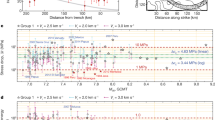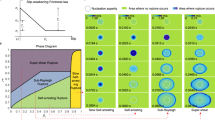Abstract
Although by definition tectonic earthquakes may nucleate anywhere within the seismogenic layer, in almost all cases those earthquakes that become large nucleate near the base of the seismogenic layer. Because frictional strength and stress-drop should increase with depth and in situ stress measurements suggest that the ambient stress increases with depth, we have examined spontaneous rupture models with gradients of both average stress-drop and average strength relative to ambient stress to determine whether this explains the observed phenomena. We report here that ruptures that are nucleated with in the low stress-drop (shallow) regions of the model are inhibited from propagating, but those that are nucleated within the high stress-drop regions can propagate over the entire fault plane.
This is a preview of subscription content, access via your institution
Access options
Subscribe to this journal
Receive 51 print issues and online access
$199.00 per year
only $3.90 per issue
Buy this article
- Purchase on Springer Link
- Instant access to full article PDF
Prices may be subject to local taxes which are calculated during checkout
Similar content being viewed by others
References
Kelleher, J., Sykes, L. & Oliver, J. J. geophys. Res. 78, 2547–2585 (1973).
Sibson, R. H. Bull. seism. Soc. Am. 72, 151–163 (1982).
Byerlee, J. D. Geofis. pura appl. 116, 615–626 (1978).
Byerlee, J. D. Int. J. Rock Mech. Mining Sci. 7, 577–582 (1970).
Scholz, C. H., Molnar, P. M. & Johnson, T. J. geophys. Res. 77, 6392–6406 (1972).
Boatwright, J. Terra Cognita 2, 166 (1982).
McGarr, M., Zoback, D. & Hanks, T. C. J. geophys. Res. 87, 7797–7806 (1982).
Das, S. Geophys. J. R. astr. Soc. 62, 591–604 (1980).
Das, S. Geophys. J. R. astr. Soc. 67, 375–393 (1981).
Burridge, R. & Halliday, G. S. Geophys. J. R. astr. Soc. 25, 261–283 (1971).
Das, S. & Aki, K. Geophys. J. R. astr. Soc. 50, 643–668 (1977).
Hanks, T. C. J. geophys. Res. 79, 1215–1229 (1974).
House, L. & Boatwright, J. J. geophys. Res. 85, 7151–7165 (1980).
Author information
Authors and Affiliations
Rights and permissions
About this article
Cite this article
Das, S., Scholz, C. Why large earthquakes do not nucleate at shallow depths. Nature 305, 621–623 (1983). https://doi.org/10.1038/305621a0
Received:
Accepted:
Issue Date:
DOI: https://doi.org/10.1038/305621a0
This article is cited by
-
Production-induced seismicity indicates a low risk of strong earthquakes in the Groningen gas field
Nature Communications (2024)
-
Reply to: Multiple induced seismicity mechanisms at Castor underground gas storage illustrate the need for thorough monitoring
Nature Communications (2022)
-
Multiple induced seismicity mechanisms at Castor underground gas storage illustrate the need for thorough monitoring
Nature Communications (2022)
-
Frictional stability of porous tuff breccia under subsurface pressure conditions and implications for shallow seismicity
Earth, Planets and Space (2021)
-
Potential seismogenic asperities in the Garhwal–Kumaun region, NW Himalaya: seismotectonic implications
Natural Hazards (2021)
Comments
By submitting a comment you agree to abide by our Terms and Community Guidelines. If you find something abusive or that does not comply with our terms or guidelines please flag it as inappropriate.



